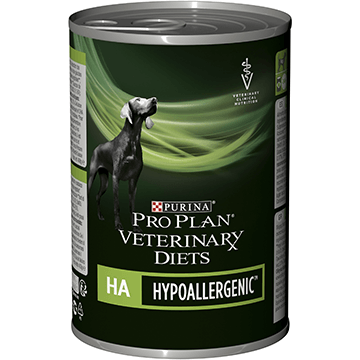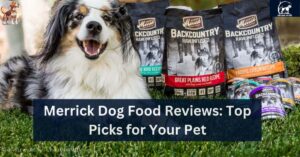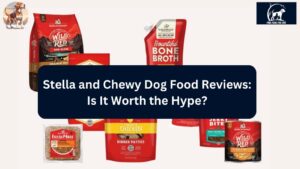Hypoallergenic wet dog food is specially formulated to minimize allergic reactions in dogs. It contains limited ingredients, often excluding common allergens like grains and certain proteins.
Choosing the right food for your dog is crucial for their health and well-being. Hypoallergenic wet dog food provides a solution for pets with food sensitivities or allergies. These diets typically feature novel proteins and fewer ingredients, making them easier to digest.
Many pet owners find that switching to hypoallergenic options can reduce symptoms like itching, digestive upset, and skin irritations. By focusing on high-quality ingredients, these foods can promote a healthier coat and improved energy levels. Understanding your dog's unique dietary needs can lead to a happier, healthier life for your furry companion.

Why Hypoallergenic Wet Dog Food?
Many dogs suffer from food allergies. These allergies can lead to health issues. Hypoallergenic wet dog food offers a solution. It helps reduce allergic reactions. This type of food is easier to digest. Dogs can thrive on specially formulated diets.
The Rise In Dog Food Allergies
Dog food allergies are becoming more common. Factors include:
- Processed ingredients
- Environmental changes
- Genetic predisposition
Common symptoms of allergies include:
- Itchy skin
- Digestive problems
- Ear infections
Identifying food allergies is crucial. Hypoallergenic diets can help manage symptoms.
Wet Food Vs. Dry Food For Allergies
Choosing between wet and dry food matters. Here are some key differences:
| Feature | Wet Food | Dry Food |
|---|---|---|
| Moisture Content | High | Low |
| Digestibility | More digestible | Less digestible |
| Palatability | Highly palatable | Less palatable |
| Convenience | Less convenient | More convenient |
Wet food may be better for sensitive dogs. It can help with hydration. Many dogs enjoy the taste of wet food. Dry food has its benefits too. It is often more convenient for pet owners. Consider your dog's needs when choosing food.
Identifying Allergies In Dogs
Identifying allergies in dogs is crucial for their health. Allergies can cause discomfort and stress. Hypoallergenic wet dog food can help relieve symptoms. Understanding how to spot allergies is the first step.
Common Symptoms
Dogs may show various symptoms of allergies. Common signs include:
- Itching: Persistent scratching or licking.
- Red or inflamed skin: Often found on paws or ears.
- Ear infections: Frequent shaking of the head.
- Digestive issues: Vomiting or diarrhea.
- Respiratory problems: Coughing or sneezing.
Not every dog shows the same symptoms. Some may have mild reactions, while others can suffer severely.
Diagnosing Food Allergies
Diagnosing food allergies in dogs involves several steps:
- Veterinary consultation: A vet can evaluate symptoms.
- Elimination diet: Remove potential allergens from the diet.
- Monitoring: Observe for symptom improvement over time.
- Reintroduction: Gradually add foods back to identify triggers.
Vets may also recommend testing. Blood tests or skin tests can help confirm allergies.
| Step | Description |
|---|---|
| 1 | Consult a vet for an initial assessment. |
| 2 | Start an elimination diet to identify allergens. |
| 3 | Monitor symptoms and note any changes. |
| 4 | Reintroduce foods to find specific triggers. |
Identifying allergies helps in choosing the right hypoallergenic wet dog food.
Ingredients To Avoid
Choosing the right hypoallergenic wet dog food is crucial. Certain ingredients can trigger allergies. Knowing what to avoid helps keep your dog healthy.
Allergenic Proteins And Additives
Proteins are the main culprit in dog allergies. Some common allergenic proteins include:
- Beef
- Chicken
- Lamb
- Fish
Many dogs also react to additives. Avoid these harmful ingredients:
- Artificial colors
- Preservatives
- Flavor enhancers
Choosing a food with limited ingredients reduces allergy risks. Always check for protein sources before buying.
Understanding Food Labels
Reading food labels can be tricky. Focus on the first five ingredients listed. These are the most significant components.
| Ingredient Type | Examples to Avoid |
|---|---|
| Animal Proteins | Beef, Chicken, Lamb |
| Grains | Wheat, Corn, Soy |
| Additives | Colors, Preservatives, Flavorings |
Look for simple, whole ingredients. Avoid foods with long ingredient lists. The more natural, the better for your dog.

Purina Pro Plan
Choosing The Right Hypoallergenic Wet Food
Choosing the right hypoallergenic wet dog food can be challenging. The right food helps dogs with allergies thrive. Focus on ingredients and nutritional value to make informed choices.
Single Protein Sources
Single protein sources are key in hypoallergenic diets. They reduce the risk of allergic reactions. Here’s why they matter:
- Limited ingredients: Fewer ingredients help identify triggers.
- Easy digestion: Simple proteins are easier for dogs to digest.
- Variety: Options include chicken, beef, lamb, and fish.
Consider these popular single protein sources:
| Protein Source | Benefits |
|---|---|
| Chicken | High in protein and widely accepted. |
| Beef | Rich flavor, great for picky eaters. |
| Lamb | Less common, may suit sensitive dogs. |
| Fish | Omega-3 fatty acids support skin health. |
The Role Of Novel Ingredients
Novel ingredients play a crucial role in hypoallergenic wet food. They help avoid common allergens. Using unique sources can prevent reactions.
- Uncommon proteins: Options like kangaroo or rabbit.
- Alternative grains: Quinoa or sweet potatoes instead of wheat.
- Unique vegetables: Peas or pumpkin for added nutrition.
Benefits of novel ingredients include:
- Reducing allergy symptoms.
- Supporting overall health.
- Encouraging a diverse diet.
Choose foods with novel ingredients to keep your dog healthy.
Top Hypoallergenic Wet Food Brands
Choosing the right hypoallergenic wet dog food is essential. These foods help dogs with allergies or sensitivities. Several brands offer high-quality options. Below are some of the best hypoallergenic wet food brands available.
Brand Reviews
| Brand | Key Features | Best For |
|---|---|---|
| Hill's Prescription Diet |
| Dogs with severe allergies |
| Royal Canin |
| Dogs with skin issues |
| Blue Buffalo Basics |
| Dogs with food sensitivities |
| Wellness Simple |
| Dogs with digestive issues |
Cost Vs. Quality
Understanding the balance between cost and quality is vital. Hypoallergenic wet dog food can vary in price. Choosing a high-quality brand often means better ingredients.
- Affordable Options: Brands like Blue Buffalo offer value without compromising quality.
- Premium Brands: Hill's and Royal Canin tend to be pricier but provide specialized nutrition.
- Long-term Health: Investing in good food may save on vet bills.
Consider your dog's specific needs. Quality ingredients lead to better health. Always consult your vet for recommendations. This ensures the best choice for your furry friend.
Home-cooked Vs. Commercial Options
Choosing between home-cooked and commercial hypoallergenic wet dog food is essential. Each option has its benefits and drawbacks. Understanding these can help you make the best choice for your furry friend.
Pros And Cons
| Option | Pros | Cons |
|---|---|---|
| Home-Cooked |
|
|
| Commercial |
|
|
Homemade Dog Food
Recipes For Sensitive Pups
Here are some simple home-cooked recipes. They cater to sensitive tummies.
- Chicken and Rice
- 2 cups of cooked chicken, shredded
- 1 cup of cooked white rice
- 1/2 cup of carrots, chopped
- Mix together and serve.
- Beef and Sweet Potatoes
- 1 pound of lean ground beef
- 1 cup of sweet potato, mashed
- 1/2 cup of peas
- Cook beef, mix with sweet potato and peas.
- Fish and Quinoa
- 1 cup of cooked fish, deboned
- 1 cup of cooked quinoa
- 1/2 cup of spinach, steamed
- Combine all ingredients before serving.
These recipes provide balanced nutrition. They are easy to digest and tasty. Always consult a vet before making significant changes to your pup's diet.
Transitioning To Hypoallergenic Food
Switching your dog to hypoallergenic wet food can greatly improve their health. Many dogs have food sensitivities. A hypoallergenic diet helps reduce these issues. Follow the steps below to make this transition smooth.
Step-by-step Guide
- Consult Your Vet: Talk to your veterinarian first. They can recommend the best food.
- Choose the Right Food: Pick a high-quality hypoallergenic wet dog food. Look for limited ingredients.
- Gradual Introduction: Mix the new food with the old food. Start with a small amount of new food.
- Increase Gradually: Slowly increase the amount of new food. Do this over a week or two.
- Monitor Changes: Keep an eye on your dog's reactions. Look for signs of improvement or issues.
Monitoring Your Dog’s Reaction
Watch your dog closely after switching foods. Signs of allergies can include:
- Itching or scratching
- Red or inflamed skin
- Digestive issues like diarrhea
- Ear infections
Keep a journal of any changes. Note down:
| Date | Food Amount | Reaction |
|---|---|---|
| Day 1 | 25% new, 75% old | No visible reaction |
| Day 7 | 50% new, 50% old | Minor itching |
| Day 14 | 75% new, 25% old | No issues |
| Day 21 | 100% new | Improvement noted |
Take advice from Pet Expert Dr Marty
ESA Pet is an online service that helps you get a legitimate ESA letter
Pet vitamin supplements and grooming products
Report any serious reactions to your vet. Quick action is important.
Additional Care For Dogs With Food Allergies
Managing food allergies in dogs requires careful attention. A hypoallergenic diet is just one part. Owners must consider supplements, regular vet visits, and overall health.
Supplements And Probiotics
Supplements can support dogs with food allergies. They help improve digestion and boost immunity. Probiotics are especially beneficial.
- Omega-3 Fatty Acids: Reduce inflammation and improve skin health.
- Digestive Enzymes: Aid in food breakdown for better nutrient absorption.
- Probiotics: Balance gut bacteria for optimal digestion.
These supplements work best with a vet's guidance. Always choose high-quality products that suit your dog's needs.
Regular Veterinary Check-ups
Frequent vet visits are crucial for dogs with allergies. Regular check-ups help monitor health and adjust diets.
| Check-Up Frequency | Purpose |
|---|---|
| Every 6 months | General health assessment |
| Every 3 months | Monitor allergy symptoms |
| As needed | Address specific health concerns |
Communication with the vet is vital. Report any changes in behavior or symptoms. Early detection leads to better outcomes.

Hill's Science Diet
Frequently Asked Questions About Hypoallergenic Wet Dog Food
What Is Hypoallergenic Wet Dog Food?
Hypoallergenic wet dog food is specially formulated to reduce allergic reactions in dogs. It typically contains limited ingredients and avoids common allergens like grains and certain proteins. This type of food helps dogs with food sensitivities to thrive while ensuring they receive balanced nutrition.
Why Choose Wet Dog Food For Allergies?
Wet dog food for allergies provides higher moisture content, which supports hydration. It often contains fewer preservatives and additives, making it gentler on sensitive stomachs. Additionally, the palatable texture can entice picky eaters, helping ensure your dog enjoys their meals.
How Can I Tell If My Dog Needs Hypoallergenic Food?
Signs that your dog may need hypoallergenic food include persistent itching, digestive issues, or skin irritations. Consult your veterinarian to determine if allergies are the cause. They may recommend an elimination diet to pinpoint specific allergens before switching to hypoallergenic options.
Are There Benefits To Hypoallergenic Dog Food?
Yes, hypoallergenic dog food can alleviate allergy symptoms and promote overall health. It helps reduce inflammation, improves digestion, and enhances skin condition. By using high-quality ingredients, it supports your dog's immune system and can lead to a happier, healthier life.
Conclusion
Choosing hypoallergenic wet dog food can greatly benefit pets with food sensitivities. This type of food offers balanced nutrition while minimizing allergic reactions. Always consult your vet before making changes to your dog’s diet. Prioritizing your dog's health ensures they live a happy and vibrant life.
Your furry friend deserves the best!

















